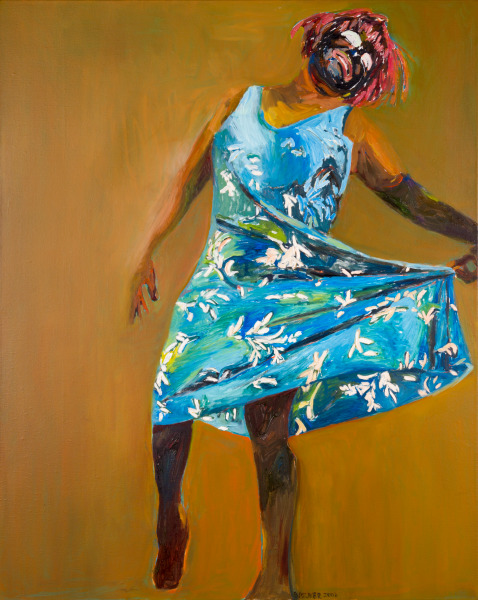The Mint Museum has pieces of its collection spread across two buildings; Mint Museum Uptown and Mint Museum Randolph. These collections can be seen on view alongside our special exhibitions.
The Mint Museum is working diligently to ensure that all objects from our collection are represented on our website, at this time only a portion are available for view.
oil paint canvas
Currently on view at Mint Museum--UPTOWN
Museum Purchase: Funds provided by Jay Everette, Ronald Carter, Cheryl Palmer and Frank Tucker, Andy Dews and Tom Warshauer, Dee Dixon, Patty and Alex Funderburg, Michael J. Teaford and R.K. Benites, Sharon and Rob Harrington, June and Ken Lambla, Mike Davis, Judy and Patrick Diamond, Anonymous Donor in honor of Amber Smith, Anonymous Donor
In "Dora’s Dance," Beverly McIver uses highly personal symbolism to present a complex and multilayered subject. Growing up in Greensboro, N.C. during the 1960s, McIver’s upbringing was steeped in the Civil Rights Movement; its impact on the country, and the South in particular, left a lasting impression on her. Attending a predominately white high school, McIver felt extreme economic and racial disparity between herself and her classmates. During her teens, she joined a clown club at school, where she trained as a clown and painted herself in “whiteface.” Assuming this disguise, she felt a freedom in her identity and a mobility she lacked when not in costume. In the club, she was only allowed to be a whiteface clown, so when she later discovered she could paint herself “in blackface” it was a liberating gesture, one that affirmed, instead of hid, her African-American identity. The “Dora” character was inspired by an elderly woman McIver met at a Mississippi nursing home who had spent her life in the South working as a housemaid. Although Dora desperately wanted to leave the nursing home, she was never able to. Dora’s carefree sway and joyful expression represents the hope for a personal liberation similar to Beverly’s own liberation through her self-styled creativity. "Dora’s Dance" is thus an expression of affirmation and freedom.
Accession Number: 2013.52
Measurements:
Copyright Information:
NEPL Mint signed nonexclusive license with artist 2017
In order to access a high-resolution image, please submit a request via the Mint’s Reproduction Request Form. Fees may apply.

All records for works of art published on mintmuseum.org have been reviewed by curatorial staff but may be incomplete. Our collections database comprises information gathered over the museum’s history; consequently, some records may be missing information, include offensive or discriminatory language, or reflect outdated ideas and analyses. The Mint is committed to addressing these issues and revising our records so as to maintain the highest possible degree of accuracy in accordance with scholarly standards.
If you would like to suggest improvements to a record, please submit your feedback here.
The Museum assumes no responsibility for infraction of copyright laws, invasion of privacy or improper and /or illegal use that may arise from reproduction of this image. The user assumes full responsibility for the use of images obtained from the Museum, to obtain permission from copyright holders where applicable and to hold harmless the Museum and its agents against any and all damages and claims arising or resulting from the use of the images.